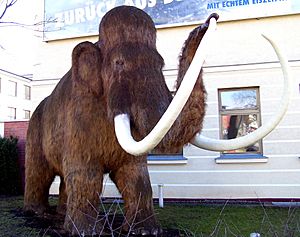Pleistocene facts for kids

The Pleistocene was a very long time in Earth's history. It started about 2.6 million years ago and ended around 11,700 years ago. This period came after the Pliocene and before our current time, called the Holocene. It's the first part of the Quaternary period.
The Pleistocene is famous for its many ice ages. An ice age is when the world gets much colder for a very long time. During these cold times, huge sheets of ice, called glaciers, covered large parts of the Earth.
Contents
What Was the Ice Age Like?
During the coldest parts of the Pleistocene, vast areas were covered in ice. For example, much of North America, including the area around the Great Lakes, was under ice. All of northern Russia and Europe were also frozen. Even England was covered in ice down to the Thames.
These very cold periods were called "glacial periods." They were broken up by shorter, warmer times called "interglacials." During interglacials, the ice would melt back a bit.
Animals of the Pleistocene
Many amazing animals lived during the Pleistocene, but most of them are now extinct. This means they no longer exist. Scientists believe that changes in the climate and hunting by early humans led to their disappearance.
Many of the mammals from this time were much larger and hairier versions of animals we see today.
- The Glyptodon was like a giant armadillo with a huge, bony shell.
- Mammoths were huge, hairy elephants with long, curved tusks. They were well-suited for the cold climate.
Early Humans
Ancient human species also lived during the Pleistocene. In Europe and Asia, the Neanderthals (Homo neanderthalensis) lived until about 30,000 years ago. They had large brains and were very skilled at surviving in cold environments.
Modern humans, Homo sapiens, did not come from Neanderthals. Instead, our species first appeared in Africa from a different branch of the human family tree.
Related pages
Images for kids
-
The maximum extent of glacial ice in the north polar area during the Pleistocene Period
-
Ice ages as reflected in atmospheric CO2, stored in bubbles from glacial ice of Antarctica
-
Pleistocene of Northern Spain, including woolly mammoth, cave lions eating a reindeer, horses, and woolly rhinoceros
-
Pleistocene of South America, including Megatherium and two Glyptodon
See also
 In Spanish: Pleistoceno para niños
In Spanish: Pleistoceno para niños







